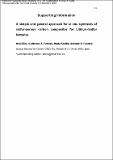Por favor, use este identificador para citar o enlazar a este item:
http://hdl.handle.net/10261/198673COMPARTIR / EXPORTAR:
 SHARE SHARE
 CORE
BASE CORE
BASE
|
|
| Visualizar otros formatos: MARC | Dublin Core | RDF | ORE | MODS | METS | DIDL | DATACITE | |

| Título: | A simple and general approach for in situ synthesis of sulfur–porous carbon composites for lithium–sulfur batteries |
Autor: | Díez Nogués, Noel CSIC ORCID ; Álvarez Ferrero, Guillermo CSIC ORCID ; Sevilla Solís, Marta CSIC ORCID ; Fuertes Arias, Antonio Benito CSIC ORCID | Fecha de publicación: | 7-oct-2019 | Editor: | Royal Society of Chemistry (UK) | Citación: | Sustainable Energy and Fuels 3(12): 3498-3509 (2019) | Resumen: | orous carbon materials constitute an excellent conductive matrix for the immobilization of sulfur in the cathode of lithium–sulfur batteries. Herein, we provide a novel, easy, sustainable, general and scalable procedure for the preparation of such cathodes, which combines in the same process both the generation of a S-doped porous carbon and the incorporation of elemental sulfur within the pores. To achieve this, a biomass-based substance (i.e., tannic acid) is activated with sodium thiosulfate, yielding a carbonized solid that includes a high-surface area carbon (up to 2550 m2 g−1) and sodium polysulfides. Once this solid is immersed in an acid medium, the polysulfides generated as activation by-products are oxidized in situ to elemental sulfur that spontaneously diffuses into the pores of the carbon, which gives rise to the hybrid sulfur–carbon composite. When tested as cathodes in lithium–sulfur batteries, these hybrid materials exhibit high sulfur utilization (∼80%) even for the composites with a sulfur content as high as 82%, as well as an excellent rate performance (590 mA h g−1 S at 5C). The cycling stability of the batteries was confirmed by their low capacity fading (0.049% of capacity decay per cycle), maintaining 85% of their initial capacity after 300 charge–discharge cycles at 1C. Cathodes with a high sulfur loading (7.1 mg S per cm2) were steady cycled providing reversible areal capacities of 4.4 mA h cm−2 at 0.2C after 100 charge–discharge cycles. | Versión del editor: | https://doi.org/10.1039/c9se00722a | URI: | http://hdl.handle.net/10261/198673 | DOI: | 10.1039/c9se00722a | E-ISSN: | 2398-4902 |
| Aparece en las colecciones: | (INCAR) Artículos |
Ficheros en este ítem:
| Fichero | Descripción | Tamaño | Formato | |
|---|---|---|---|---|
| Approach_synthesis_sulfur_Diez_2019.pdf | 1,7 MB | Adobe PDF |  Visualizar/Abrir | |
| Approach_synthesis_sulfur_Diez_2019_SI.pdf | Supplementary Information | 833,48 kB | Adobe PDF |  Visualizar/Abrir |
CORE Recommender
SCOPUSTM
Citations
22
checked on 10-abr-2024
WEB OF SCIENCETM
Citations
23
checked on 19-feb-2024
Page view(s)
301
checked on 22-abr-2024
Download(s)
285
checked on 22-abr-2024
Google ScholarTM
Check
Altmetric
Altmetric
Este item está licenciado bajo una Licencia Creative Commons

